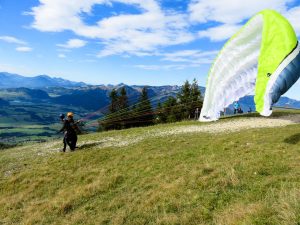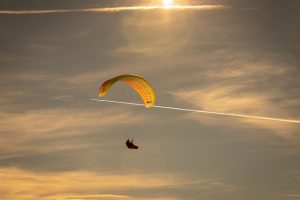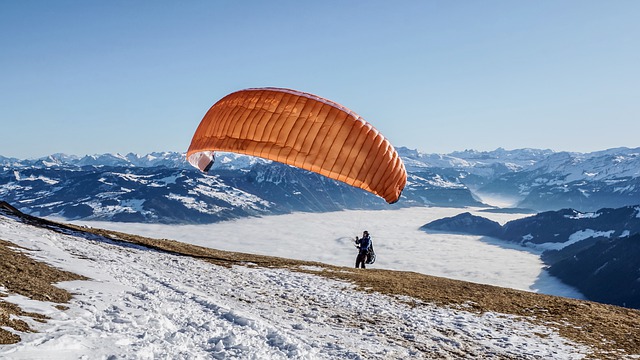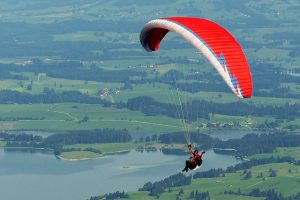What is Paragliding?
Paragliding is flying a paraglider – a wing made of matter. A brief note: the word paraglider is derived from the words parachute and glider. A paraglider has no engine, it is a glider with a soft two-shell wing, which is inflated through the air intakes by an oncoming flow of air. The lift is created by the contrary air flow around the wing profile. The lifting force maintains a certain speed relative to the air, the vector of lifting force can be directed both forward and upward. The airspeed is limited only by the drag force of the wing, slings and the pilot himself. The stored altitude is used to overcome the drag force. The paraglider gradually plans, reducing altitude, but does not reduce it quickly, because it uses the lifting force of upward air currents. The air currents are created by the terrain and the wind.
There are two “types” of flight depending on the air currents: dynamic flight – this is when the air currents, i.e. the wind moves toward the mountain, and thermic flight – when heated air rises up. Due to the presence of thermals (mostly in the warm season, it is possible to gain altitude up to the border of atmospheric inversion (usually on this border passes the cloud base). There is one more – mixed type of flows: thermodynamics, when paraglider flies near slope, but at higher altitude. Pilots start up on mountain slopes strictly against wind, at first use ascending dynamic flow (dynamo) and after gaining sufficient altitude (up to 3500 meters) they go to the route using falling thermal flows (thermals). To initially gain altitude and enter the zone of thermal flows, they use a winch pull, which can be active, i.e. having their own engine, and passive, using the speed of the vehicle.

Paragliding is a very fashionable, but at the same time not expensive sport. In order to engage in paragliding, you do not need to be a master of sports, have a muscular physique or have bogatyr health. For practicing paragliding your desire and good health are enough. People with heart diseases paragliding lessons are strictly contraindicated. Paragliding gained popularity among both men and women thanks to its simplicity and low cost. Unfortunately, in the European part of Russia paragliding can not be called a very popular sport because of the lack of elevation.
Paragliding equipment fits into a large backpack that can be easily thrown on your shoulders, can be carried in the trunk and even on the plane there is no separate fee for transporting a paraglider. With a paraglider one is independent and free, which seems very romantic and extreme. You can go or fly to another country or to remote Russian cities with a backpack on your back, in order to feel the sky. Paragliding gives unforgettable feelings of freedom and independence, joy and seeing the earth from a new perspective.
The main parts in the construction of a paraglider are: canopy, sling system, loose ends, suspension system. The canopy is made of a very strong airtight fabric. Usually it is good quality nylon or polyester. The dome consists of two parts: the upper and lower, connected to each other by ribs – crosspieces. Nerves have an aerodynamic profile and divide the wing into caissons – separate sections. At the front, the upper and lower surfaces of the wing do not connect, thus forming an air intake, through which the air fills the wing. The wing becomes rigid due to internal air pressure.

Small holes are made in the ribs, allowing air to circulate freely inside the wing. The nose part of the nerves is reinforced by a stitching of dense fabric, and on the bottom of the nerves are sewn loops, to which the slings are attached. In these places the stitched fabric also strengthens the rigidity. The sling system of the paraglider is built on the principle of branching and consists of several rows and tiers. Control lines are attached to the rear edge of the wing. Braided slings with breaking strength of 80, 120, 200 and 250 kg are used for making the sling system. On sport paragliders sometimes microslinging without a braid is used. When designing, the principle of diversity is followed, so stronger slings are placed on the lower tiers.
The slings are stitched at the edges and connected by a “knot”. The bottom tier is attached to the free ends, made of durable tape, forming three or four rows, to which through the locks – connectors are attached slings. For convenience, each row is named: the first A, second B, third C, fourth D (if available). The slings are made of Kevlar or polyethylene, because they must be both strong and thin, so as not to create resistance when planning, to simplify the design slings are divided into two floors. The control slings, which are attached to the trailing edge, have handles for convenience and are painted in a bright color.
The design of some loose ends allows the sling system geometry to be altered by a gas pedal or trimmer. These devices allow the pilot to change the wing angles and balancing speed of the flight. The harness system is made of durable tapes and fabrics. The base of the suspension system is the power harness to which the loose ends are attached and the pilot’s seat is supported. The leg, shoulder, lap and chest harnesses are connected by split locks. When buckled, they form a cozy basket from which it is impossible to fall out. There are now many variations of harness systems with built-in spare parachute, shock absorbers and treads. It is very important that the harness has proper alignment, good stability and handling.
 source
source
The straps that connect the slings to the seat play a major role. The slings are made of one-inch braid and are attached on the sides of the seat to the straps with steel links. The back straps have control sling rings to keep the slings from flying away. The suspension system, consisting of seat and backrest, has a horizontal strap or 2 oblique straps at the front. They have advantages and disadvantages – one allows you to move your body weight while controlling the canopy, the second stabilizes some flight characteristics. Back protection is very important, which is given increased attention in emergency situations. A parachute backstay is placed near the seat in the back, its handle in a convenient place in plain sight.
When making a backup parachute, durable synthetic airtight fabrics are used. Such fabric doesn’t stick and doesn’t electrify. Most reserve parachutes are built on the basis of a round canopy with a retracted top. This kind of canopy will allow the reserve parachute to open quickly and provides high specific resistance of the system. The disadvantage is tendency to swing. It is combated by using special holes, petals, etc.
The parachute is packed in a container and placed in the suspension system. The container has a ring handle sewn onto it, which is used to remove it from the suspension system. The shorter the handle, the more convenient it is to drop the container and there is less chance that something will get tangled. The greatest safety is provided by the location of the spare in front, on the side or under the seat. The widespread placement in the back is convenient in terms of layout, but less safe.

A basic training course can be completed in a week. And, if treated with respect, knowledge and experience, you will have a great sporting experience. The basic rules of paragliding are quick and easy to learn, but it takes great knowledge, caution and maturity to make the sport forever safe and enjoyable. The breathtaking beauty of paragliding will be with you from the beginning. Safety and confidence will come after a while.